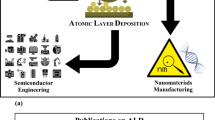Abstract
The generalized results of studying the formation of nanolayers of tantalum- and aluminum oxides, as well as their multilayer compositions obtained by molecular layering on a silicon (100) surface, are presented. It is established that the formation of oxide layers by the alternating chemisorption of metal halide and water vapors can occur via three mechanisms: a reaction between the components in the polymolecular adsorbed layer with the formation of hydrated oxides, the sequential buildup of monomolecular layers (layered growth mechanism), and the formation and subsequent development of two-dimensional islet structures. The conditions for the implementation of these growth mechanisms, as well as for the implementation of multilayer compositions with alternating zones of these oxides, are determined. An exchange activator triethylamine is used to stabilize the process of formation of the oxide layer and to extend the temperature range of layer growth. The dielectric characteristics of the synthesized nanostructures are evaluated, as well as the influence of heat treatment on these characteristics.




Similar content being viewed by others
REFERENCES
V. B. Aleskovskii, Vestn. Akad. Nauk SSSR, No. 6, 48 (1975).
Yu. K. Ezhovskii, Russ. J. Phys. Chem. A 91, 739 (2017).
S. V. Bukin and A. S. Shulakov, J. Surf. Invest.: X-Ray, Synchrotron Neutron Tech. 1, 67 (2007).
J. Gelatos, L. Chen, H. Chung, and R. Thakur, Solid State Technol. 2, 44 (2003).
J. T. Gaskins, P. E. Hopkins, and D. R. Merrill, ECS J. Solid State Sci. Technol. 6 (10), 189 (2017).
T. Gougousi, Prog. Cryst. Growth Charact. Mater. 62 (4), 1 (2016).
Yu. K. Ezhovskii, Inorg. Mater. 55, 101 (2019).
Yu. K. Ezhovskii, J. Surf. Invest.: X-Ray, Synchrotron Neutron Tech. 9, 462 (2015).
V. K. Gromov, Introduction to Ellipsometry (Leningrad. Gos. Univ., Leningrad, 1986) [in Russian].
V. I. Nefedov and V. T. Cherepin, Physical Methods for Studying the Surface of Solids (Nauka, Moscow, 1984) [in Russian].
V. I. Nefedov, X-Ray Electron Spectroscopy of Chemical Compounds (Khimiya, Moscow, 1984) [in Russian].
Handbook of X-Ray Photoelectron Spectroscopy (Perkin-Elmer, Eden Prairie, MN, 1978).
V. B. Lazarev, V. G. Krasov, and I. S. Shaplygin, Electrical Conductivity of Oxide Systems and Film Structures (Nauka, Moscow, 1979) [in Russian].
Author information
Authors and Affiliations
Corresponding author
Additional information
Translated by S. Rostovtseva
Rights and permissions
About this article
Cite this article
Ezhovskii, Y.K. Nanolayers of Tantalum- and Aluminum Oxides and Dielectric Compositions Based on Them. J. Surf. Investig. 15, 267–272 (2021). https://doi.org/10.1134/S1027451021010225
Received:
Revised:
Accepted:
Published:
Issue Date:
DOI: https://doi.org/10.1134/S1027451021010225




